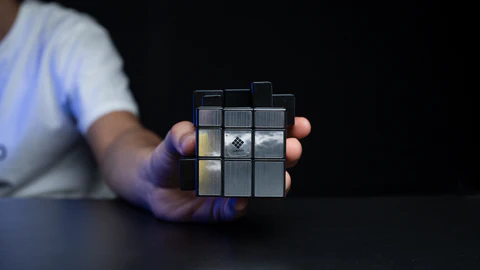The world of puzzles has always captivated human minds, challenging our intellect and creativity. Among the myriad of perplexing puzzles, the mirror cube stands out as a unique and visually stunning challenge. Also known as the mirror block or Bump Cube, this three-dimensional twisty puzzle has gained popularity for its deceptive simplicity and the mesmerizing patterns it creates. In this article, we will delve into the intriguing universe of the mirror cube, exploring its history, solving techniques, and the underlying principles that make it a fascinating addition to the realm of puzzles.
History of the Mirror Cube
The mirror cube is a variant of the classic Rubik’s Cube, which was invented in 1974 by Hungarian sculptor and professor of architecture Ernő Rubik. The Rubik’s Cube gained immense popularity in the 1980s and became a cultural phenomenon. Inspired by its success, puzzle enthusiasts and designers began exploring new variations to add complexity and excitement to the traditional cube.
The mirror cube made its debut in the early 2000s, capturing the attention of cubers worldwide. It was invented by Hidetoshi Takeji, a Japanese puzzle designer, and was initially known as the “Bump Cube.” However, it gained the name “mirror cube” due to its reflective, mirror-like appearance.
Design and Structure
At first glance, the mirror cube appears to be a daunting puzzle, but its underlying mechanism is deceptively simple. Unlike the Rubik’s Cube, which uses colored stickers on each face, the mirror cub’e employs differently shaped blocks on its faces. The puzzle is made up of small, cubical pieces that can move independently. Each piece has a unique shape, and the challenge lies in maneuvering these pieces to align them properly.
The mirror cub’e typically features a metallic or reflective surface on its exterior, enhancing its visual appeal. The reflective stickers or panels add an extra layer of complexity to the solving process, as the puzzle not only demands logical thinking but also an appreciation for the optical illusions created by the reflective surfaces.
Solving the Mirror Cube
Solving the mirror cube requires a combination of spatial reasoning, pattern recognition, and problem-solving skills. While the mirror cube shares some solving principles with the classic Rubik’s Cube, it introduces new challenges due to the varied shapes of its pieces and the reflective nature of its surfaces.
Understanding the Basics: Begin by familiarizing yourself with the basic structure of the mirror cube. Unlike the Rubik’s Cube, where color matching is the primary goal, the mirror cub’e requires aligning the differently shaped pieces to create a uniform, non-distorted shape on each face.
Identifying Patterns: Recognizing specific patterns on the mirror cub’e is crucial for solving it efficiently. Focus on identifying distinctive shapes and their orientations on each face, paying attention to how the reflections interact with adjacent pieces.
Layer by Layer Approach: Adopt a layer by layer solving method, similar to the traditional Rubik’s Cube. Start by solving one face and then proceed to the adjacent layers. The key is to maintain the shape of the pieces while achieving uniformity on each face.
Paying Attention to Reflections: The mirror cube’s reflective surfaces can create optical illusions, making it challenging to distinguish between different pieces. Take your time and observe the reflections to ensure accurate placement of each piece.
Trial and Error: As with any puzzle, solving the mirror cube may involve trial and error. Experiment with different movements and rotations to find the optimal sequence for solving each layer.
Challenges and Benefits
The mirror cube presents both challenges and benefits to puzzle enthusiasts.
Challenges:
Deceptive Complexity: The mirror cube’s deceptive simplicity can catch solvers off guard. Its varied shapes and reflective surfaces add an extra layer of difficulty compared to the traditional Rubik’s Cube.
Optical Illusions: The reflective surfaces can create optical illusions, making it challenging to discern the actual orientation of the pieces. Solvers must train their eyes to differentiate between real and reflected shapes.
Algorithm Learning: While the mirror cub’e shares solving principles with the Rubik’s Cube, the different shapes require new algorithms and strategies. Solvers must adapt their knowledge and learn additional techniques specific to the mirror cube.
Benefits:
Visual Appeal: The mirror cube’s shiny, reflective exterior adds a visual allure that captivates both beginners and experienced cubers. Its aesthetic appeal enhances the overall solving experience.
Cognitive Skills: Solving the mirror cub’e enhances cognitive skills such as spatial reasoning, pattern recognition, and problem-solving. The three-dimensional nature of the puzzle stimulates the brain and promotes logical thinking.
Varied Challenges: The mirror cube provides a refreshing change for those accustomed to traditional cube-solving. Its unique challenges offer a new perspective, keeping enthusiasts engaged and motivated.
Community and Competitions
The mirror cub’e has fostered a vibrant community of puzzle enthusiasts and speedcubers. Online forums, social media groups, and dedicated websites serve as platforms for enthusiasts to share solving techniques, discuss algorithms, and showcase their solving achievements.
Speedcubing competitions, where participants aim to solve cubes as quickly as possible, often include events dedicated to mirror cubes. Competitors showcase their skills and strategies, contributing to the evolution of solving techniques within the community.
Conclusion
The mirror cube, with its enigmatic design and reflective surfaces, has carved a distinctive niche in the world of puzzles. Its history, structure, solving techniques, and the challenges it presents make it a captivating and rewarding puzzle for enthusiasts of all levels. As puzzle-solving continues to evolve, the mirror cub’e stands as a testament to human ingenuity and the enduring appeal of twisting and turning our way through complex challenges. Whether you’re a seasoned speedcuber or a casual puzzle enthusiast, the mirror cub’e invites you to unlock its secrets and immerse yourself in the fascinating world of three-dimensional brainteasers.







